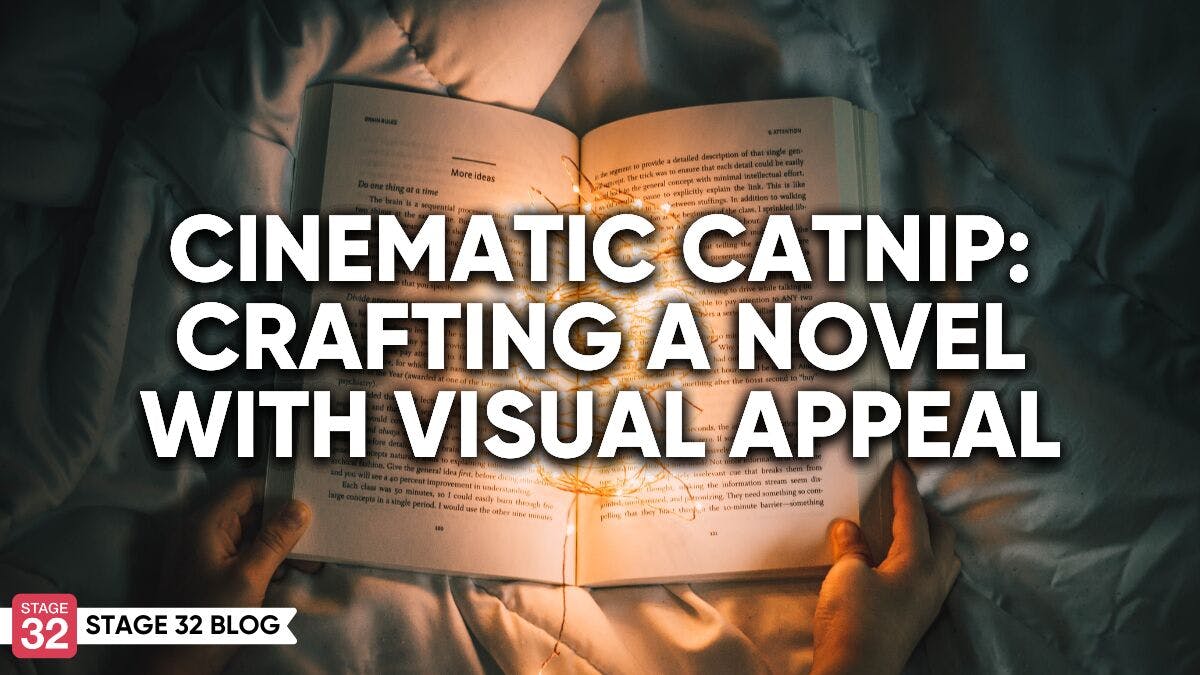Cinematic Catnip: Crafting A Novel With Visual Appeal

Cinematic Catnip: Crafting A Novel With Visual Appeal

Imagine you have pitched a twenty-five-word book logline to a publisher that not only lands you a four-book contract but also attracts interest from nine movie production companies in one week.
Let that sink in.
How would you feel? On top of the world? Like all your dreams have come true? As if you’ve been sprinkled with pixie dust and all your worries are over? Well, it happened to me, and while I did feel those things, my central emotion was panic. Why? Because the cinematic catnip I’d used to land a publisher and pique Hollywood’s interest meant I had to now write a series of books that lived up to the hype. Hence, I urge caution in using cinematic catnip. Before applying these techniques make sure you are ready for the attention.
Still here? Great. Let’s roll up our sleeves and start crafting that cinematic catnip for your novel. Based on my experience, I’ve identified six key must-haves for the highest visual impact.
Key #1) A Compelling Central Character with a Desperate Desire.

So what makes a character compelling? In a word? Agency. This boils down to the actions the characters take and the choices they make under pressure. If your character doesn’t take action toward achieving a goal or allows themselves to be tossed around by the whims of fate, they won’t produce cinematic catnip. There’s nothing for your audience to see.
But agency alone won’t create the kind of visual appeal that causes publishers or producers to sit up and take notice. For that, you need to give your characters one or more of the following—secrets they are keeping, lies they tell themselves and others, vulnerabilities, misguided beliefs, skewed values, glamorous lifestyles, interesting jobs, exotic backgrounds, fears, disabilities, bravery, sense of humor, sexiness, underdog, or unusual skills.
Once you’ve created this compelling character, they must now go in pursuit of a desperate desire. They need a goal. It can be to gain something-a job, a love interest, fame, and fortune. It can be to find something-a lost child, a buried treasure, or a missing will. It can be to escape something—a troubled marriage, a war, an illness. It can be to stop something—an explosion, a crime from being committed, a communicable disease from breaking out. Or it can be to overcome something-a disability, a disadvantaged life, or a crippling fear. Keep in mind psychologists claim there are only two fundamental reasons why people do anything. People act to either gain pleasure or to avoid pain and avoiding pain is a stronger motivation than gaining pleasure.
Here's another thing about the desperate desire. It must be concrete. The desperate desire can't be something intangible like to be a better man or to understand the meaning of love or to see the face of God. You will have inner conflicts and desires in your story, but those conflicts must occur in the context of an external goal in order to create cinematic catnip.
Key #2) A Flaw Related to the Character's Career or Situation.
A character's greatest flaw is the flipside of his virtue. The thing that saves them is the thing that will ultimately condemn them and vice versa. Your characters will of course have more than one flaw, but for the sake of your story, there is one central flaw that will drive them throughout the narrative. The secret to selecting a character's central flaw for cinematic catnip is to find the weakness that's in juxtaposition to their situation or occupation.
Key #3) A Classic Plot Device

A classic plot device (aka trope) will appeal to the greatest number of readers. Universal themes touch something primal in us all and that something primal pulls use deeper into the story and gives us a mental visual shorthand in which to view the story. It's the very foundation your premise is built on. The most crippling weakness in stories without visual appeal is the lack of a classic plot device or marketable trope. When thinking of market appeal, consider topics of interest to the highest number of people. Is it fascinating? Does it have wide commercial potential? If you write about a topic that intrigues a large number of readers, you're already well on your way to cinematic catnip. When deciding which classic plot device to pursue it's important to find a trope(s) that truly fascinates you, because your passion will show through, and nothing engages an audience more than passionate authenticity.
Key #4) A Life-Altering Inciting Incident

The inciting incident is what sets your story in motion. But in cinematic writing, the inciting incident should do more than simply start the action. It should be life-altering and force the protagonist to choose between his flaw and some opportunity.
You will know if an event is truly life-altering if action must be taken NOW! Finding the life-altering event spotlights the central story problem. And stories, especially ones with cinematic catnip, are about problems. The higher the stakes, the higher the interest. That doesn’t mean that quiet stories don’t have their place, it just means you’ve got to work harder at creating high stakes out of ordinary circumstances.
Key #5) The Innovative Idea

The innovative idea is a unique aspect of the problem that suggests surprising possibilities. It’s a twist on the trope. A curveball is thrown that will raise the stakes and increase interest. In all honesty, an innovative idea is often the most difficult aspect of cinematic catnip to nail down. It takes creativity and turning the classic plot devices on their head. Ways to arrive at an innovative idea include the following. Identifying the problem and emphasizing the conflict. Making things significantly worse for the protagonist. Twisting a traditional role. Breaking rules. Using the opposite of normal human reactions. Utilizing an unexpected setting. Bringing in celebrity appeal.
Key #6) Irony

The irony that arises from the relationship between the inciting incident and the profession or situation will add to the cinematic catnip. Think hooks. Think surprises. Think the opposite of what's expected. Irony brings complexity to a story, weaving in insight, depth, and a sense of justice to the visual tapestry.
Cinematic catnip works! It draws people to you. And while I can’t guarantee you’ll set the world on fire in record time, I can tell you people will take notice when you start injecting cinematic catnip into your stories.
Where It All Began

Below is the original blurb for my Wedding Veil Wishes series and the twenty-five-word logline that started it all.
The Sisterhood of the Traveling Pants meets Bride Magazine
Three best friends. Three heartfelt wishes. One magical wedding veil.
THE WEDDING VEIL FAIRY TALE
Once upon a time in long ago Ireland, there was a beautiful young witch with an extraordinary talent for tatting lace. People came from far and wide to buy the lovely wedding veils she made. But there were others in the community who were jealous of her success and told the magistrate she was casting spells on the men of the village. The magistrate had her arrested, but then he fell in love with the young witch. To honor him, she promised never to use magic again. She made one last wedding veil, investing it with the power to grant the wearer’s most heartfelt wish, and then she wore it on her own wedding day to the magistrate. It was passed down through the generations, but the veil was eventually lost.
WEDDING VEIL WISHES
Three best friends, Delaney, Rachel and Tish are shopping for Delaney’s wedding in an upscale vintage clothing store when they spy a most incredible wedding veil in a locked display case. Delaney wants to buy it, but the store owner says it’s not for sell and spins a fairytale about the veil’s mythological powers to grant the deepest wishes of the bride who wears it. But you better be careful what you wish for, she says, because it will surely come true. Figuring the silly legend is nothing more than a story to jack up the price, Delaney offer a hefty sum and talks the woman into selling it to her. Later, when Delaney is alone, she tries on the veil and finds herself wishing for a way out of her impending marriage.
And that’s when everything starts to go wrong...
There Goes the Bride
A high-society, commitment-phobic bride-to-be stages her own wedding day abduction only to discover the man who takes her hostage is not the kidnapper she hired.
A Dose of Reality

Now, for a dose of reality. Yes, I got a four-book deal out of my twenty-five-word pitch that oozed cinematic catnip. Yes, I had nine movie production companies—including Paramount—knocking on my door. And yes, Hallmark eventually made six movies in one year inspired by that pitch.
The catch?
I wrote the books from 2006-2007. The idea finally sold to Hallmark in 2021 and the six movies came out from 2022-2023 and broke viewing records. The good news is those four books rocketed my career, and a few books later, I hit the NYT bestseller list with a Christmas book that Hallmark then made in a seventh movie. Vanity Fair picked A Kismet Christmas as one of the top 15 Christmas movies of 2022.
So yeah, I believe in the power of cinematic catnip. I hope I’ve convinced you to give it a try.
Let's hear your thoughts in the comments below!
Got an idea for a post? Or have you collaborated with Stage 32 members to create a project? We'd love to hear about it. Email Emily at blog@stage32.com and let's get your post published!
Please help support your fellow Stage 32ers by sharing this on social. Check out the social media buttons at the top to share on Instagram @stage32 , Twitter @stage32 , Facebook @stage32 , and LinkedIn @stage-32 .
About the Author

Lori Wilde
Author
Lori Wilde is the New York Times, USA Today, and Publishers Weekly bestselling author of 97 works of romantic fiction. She’s a three-time Romance Writers of America RITA finalist and has won numerous other awards as well. Her books have been translated into 26 languages, with more than five million...





